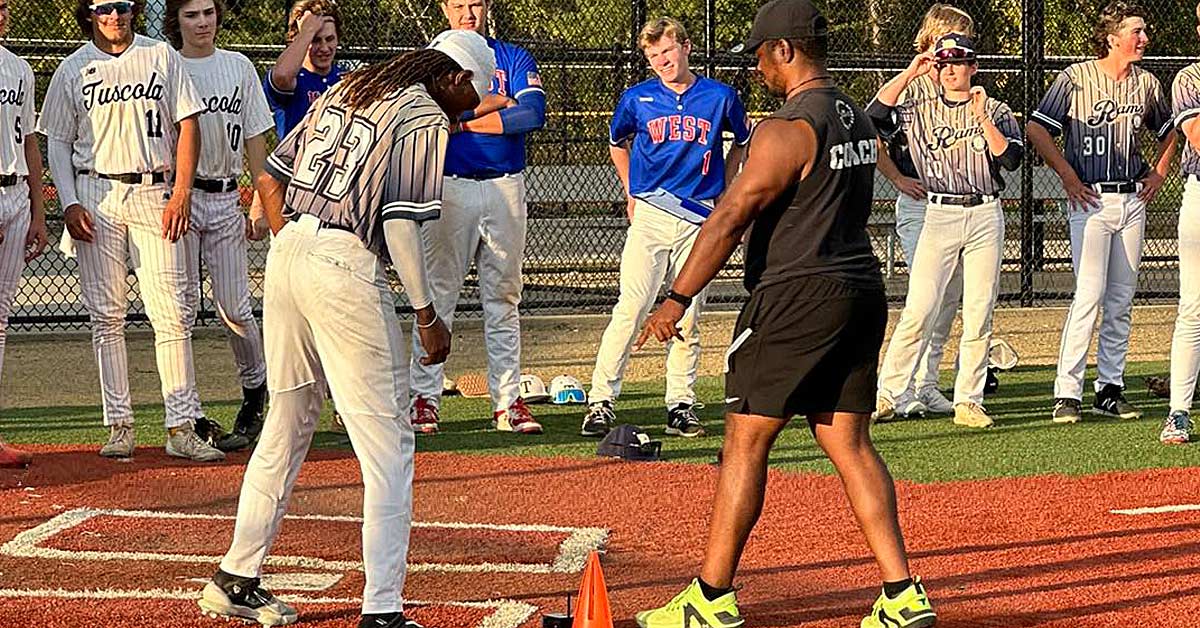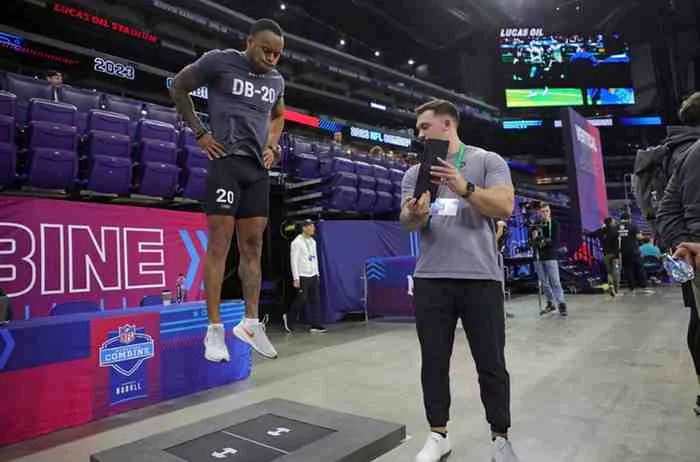In the realm of sports, the pursuit of excellence is an enduring journey marked by dedication, resilience, and a relentless commitment to pushing physical and mental boundaries. Athletes—whether seasoned professionals or aspiring amateurs—constantly seek ways to enhance their performance and gain a competitive edge. As times change and we learn more about the physiology of the body, we understand that superior athletic performance is not entirely inherited but can also be earned through hard work. As we learn more about this matter, it brings high school athletes to ask: “How can I make myself better?” I believe the answer is correct guidance from professionals, including coaches, athletic trainers, and performance coaches.
Recently, I worked with 15 schools in our county to record sprint speeds for athletes. This assessment was for high school baseball athletes, who were required to run a 60-yard sprint, which we set up on a turf field with an electronic timing laser. We asked every coach to nominate three to five of their best athletes; after those nominations, we had the athletes run through a dynamic warm-up. Following their warm-up, we had all of the athletes run that 60-yard sprint. To bring out more of a competitive edge, each high school ran back-to-back—after one high school’s athletes ran, their average time would be given, and then the next school would proceed.
For the event, the total average time was recorded at 7.3 seconds—we compared this to the average for the high school baseball team we work with, whose average time was 6.9 seconds. After discovering the difference in sprint speeds, I talked to coaches about their off-season training programs, which sparked interest and training discussions.
Training to Improve Speed in Team Sports
When athletes reach middle school and high school, their level of development begins to decrease. Many public schools do not have the funds to find a professional who can help with development during these critical times.
When athletes reach middle and high school, their level of development begins to decrease. Many schools don’t have the funds for a professional to help with development during these critical times. Share on XOver the last few years, I have led a strength and conditioning program for a local high school baseball team that has proved effective compared to the other public schools in the area. Before arriving at the school in 2019, the athletes took training into their own hands. Some trained under another sport for the fall or winter to prepare themselves for spring (football, basketball, cross country), some sought out help from local professionals, some lifted at local gyms on their own time, and others did no training at all.
I began with just a few of the team’s athletes who were looking to train at my facility; after months of training, they were prepared for the 2019 season when the spring came around. Following that season, the individuals I trained made the All-Conference list, and the head coach called and asked if he could send me any athletes who were not playing fall sports. Each year, then, we were able to make the athletes bigger, stronger, and faster for the season.
During this time, the team’s biggest goals have been to improve sprint speed and explosiveness. Following our GPP phase, this is a goal we can accomplish easily—over the years, our athletes have achieved their sprint speed goals following our training strategies.
The three primary training methodologies I use with my athletes are:
- Post-activation potentiation training (PAP). PAP refers to the phenomenon by which acute muscle force output is enhanced as a result of contractile history and is the premise upon which “complex training” is based. It has been postulated that explosive movements may be enhanced if preceded by heavy resistance exercise. This phenomenon uses loads from 75%–95% of 1RM (e.g., 85% 3RM back squat followed by a hurdle hop) (Robbins, 2005). Some of the standard PAP training methods we used were with our main barbell movements. In our last off-season programming, our athletes paired:
- Barbell back squats with a hurdle hop following the squat.
- Barbell split lunges and split jumps.
- Single-arm dumbbell bench and medicine ball slams.
- Trap bar deadlifts and depth drops.
- Weightlifting movements. Various research studies have reported improvements in sport and related performance (e.g., jump, sprint, and COD) associated with the implementation of weightlifting-based training methods. Weightlifting movements can also be broken into key positions to be strengthened and enhanced for athletic performance (e.g., jump shrug or hang high pull). The use of these high-velocity movements became a significant piece in training.We used clean progressions as some high-velocity movements to train our athletes. The overall goal is to keep the weight light but move it fast! Typical movements in our program include:
- Barbell back squats with a hurdle hop following the squat.
- Barbell split lunges and split jumps.
- Single-arm dumbbell bench and medicine ball slams.
- Trap bar deadlifts and depth drops.
- Stressing the stretch-shortening cycle. This is an eccentric-concentric coupling phenomenon in which muscle-tendon complexes are rapidly and forcibly lengthened, or stretch loaded, and immediately shortened in a reactive or elastic manner (Nimphius, 2016). We can stress the stretch-shortening cycle in many ways. To prepare our athletes for their season doing this, we used different jumps, medicine balls, and more. Some standard ways our program stresses the stretch-shortening cycle are with:
- Broad jumps.
- Depth drops.
- Medicine ball throws (overhead, seated rotational throws, behind the back).
- Loaded verticals (max weight 15 pounds).
- Landmine single-arm presses.
Where Qualified Coaches Make the Most Difference
During the WNC Fall Baseball Day, where our athletes averaged times that were .4 seconds faster than the rest of the schools, the first school I talked to had the right intentions but incorrect implementations. The resistance training program they ran had no variability. The exercises, sets, repetitions, and load of 1RM stayed the same for months at a time.
Another key difference was the implementation of their post-activation potentiation training. Their training called for 3×8 on bench at 65%–70% of their 1RM. Following that, they were prescribed eight medicine ball slams—compared to our program, which prescribes a heavier bench of 75%–95% of 1RM and 3–5 repetitions to recruit more motor units. Instead of eight medicine ball slams, we would prescribe three explosive medicine ball slams focusing on the explosiveness of the movements.
When talking to the athletes about their lifting—if they did any on their own—the typical responses were repetitions to failure, mile runs, drop sets, ladder drills, high repetition sets, and power cleans.
All of the athletes and coaches I spoke to had the goal of being more explosive, faster, and stronger. Many schools in the area have programs led by athletes who played at the college level or their head coaches, with degrees ranging from history and business to coaching, physical education, and health promotion. I failed to find a weight room attendant or coach with any certifications or degrees in exercise science, exercise physiology, or kinesiology.
Two coaches run our program: me, with a degree in exercise science and a certified strength and conditioning specialist (CSCS), supplemented by a pitching coach with a degree in exercise science who is a certified personal trainer (CPT).
My conclusion, after speaking with athletes and coaches from other schools, was that many athletes without guidance train with a bodybuilder mindset (e.g., drop sets, reps to failure, AMRPS). The incorrect application of training by themselves or by an unqualified weight room attendant can lead to adverse training effects.
Many athletes without guidance train with a bodybuilder mindset. The incorrect application of training by themselves or by an unqualified weight room attendant can lead to adverse training effects. Share on XResistance training must be heavy and fast. This will facilitate the development of fast-twitch muscle fibers. Another way to develop speed/fast-twitch fibers is by stressing the stretch-shortening cycle. Post-activation potentiation training should be executed by a heavy training stimulus (75%–95% of 1RM) (Nimphius, 2016).
Athletic development should be nurtured over time to help youth and high school athletes grow and succeed. My findings show that success and growth are not 100% down to the work ethic of athletes—there are athletes working very hard, just not in the right manner. Success and growth are also largely due to receiving proper guidance from coaches.
With correct guidance from a professional, we can help develop athletes to be the best they can be. Receiving proper guidance from coaches off the playing field can be essential to the success of a program or an individual athlete.
Since you’re here…
…we have a small favor to ask. More people are reading SimpliFaster than ever, and each week we bring you compelling content from coaches, sport scientists, and physiotherapists who are devoted to building better athletes. Please take a moment to share the articles on social media, engage the authors with questions and comments below, and link to articles when appropriate if you have a blog or participate on forums of related topics. — SF
References
Nimphius BH. “Program Design and Technique for Speed and Agility Training.” Essentials of Strength and Conditioning, Fourth Edition. 2016.
Robbins DW. “Postactivation Potentiation and Its Practical Applicability.” Journal of Strength and Conditioning Research. 2005;19(2):453–455.
Williams CE. “Youth Performance and Fitness—Strength and Conditioning Information for Parents.” Personal Training Quarterly. 2013.






